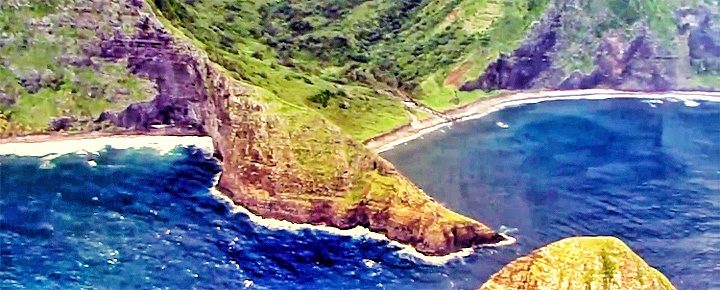Helicopter crashes in Hawaii are a deadly problem. And there have been more than sixty Hawaii helicopter tour accidents in the past forty years. Hawaii’s weather can be extreme and fast-changing, and, as a result, up to 1/3 of all Hawaii helicopter crashes may be weather-induced. The FAA saw this as an opportunity to reduce risk here in the islands.
The Federal Aviation Administration (FAA) is installing a new aviation-related weather camera system at multiple Hawaii locations. The 23 camera project is intended to improve the safety and reliability of flights to and within Hawaii. That will be of benefit to airline flights, as well as small planes and helicopters flying under FAA Visual Flight Rules.
The FAA said, “The program improves safety and efficiency by providing pilots with near real-time, visual weather information. The camera images are updated every 10 minutes and have been critical to helping pilots make better safety decisions… Cameras are positioned to view sky conditions around airports and air routes as well as extreme mountain passes… General aviation, air tour operators, passenger and cargo airlines use the cameras.”
Hawaii helicopter crashes.
Here in Hawaii, micro-climates, challenging mountainous terrain, and fast-changing weather can result in dangerous situations. These issues are frequently associated with Hawaii plane and helicopter accidents, for example.
This industry upgrade uses state of the art, reliable, portable cameras. “Project 23 will implement 23 camera locations throughout the state,” according to the FAA. Sites have already been selected on Kauai, Lanai, Maui, and Molokai following engineering surveys last year. Big Island and Oahu location studies will start next month.
Kauai flights will be the first to benefit.
The Garden Island will receive its first cameras in March, and the other islands will follow as soon as equipment and further details are completed. Each of the 23 locations will include four cameras. The Kauai implementation should be online starting this summer.
The FAA is working with stakeholders to continue identifying opportunities and monitoring progress throughout the implementation and beyond. Locations are selected based on routes where weather most frequently impacts flight ops.
The project is based on a similar camera system that the FAA has operated in Alaska over the past two decades, comprised of over 200 cameras. Colorado came online with the system last year to help with flight operations in and around the Rockies. Canada is installing a similar system again with over 200 cameras.
Check out the FAA’s cam website to monitor progress.
Beat of Hawaii © photo on a small plane flying near Molokai.







My Dad was a Navy pilot Lt.Cmdr in WWII in the Pacific and had over 8,000 flight hours. He used to mention concern over younger pilots who would have 100,250, etc…hours. He also said that accidents are nearly always the result of pilot error. If weather indicated a no go, stay grounded. Profit motive is a problem here. Disclose the honest number of hours all pilots have in the air. BEFORE passengers board the aircraft. An eye opener, for sure. And maintenance at these companies…
As a former helicopter tour pilot on Kauai, I can tell you that this won’t help! The pilots are pressured by the company owners/management to complete flights to generate revenue. There are already private webcams used to view weather conditions throughout the island and the pilots talk via air-to-air communications with what’s known as PIREPS or pilot reports on current conditions. It’s when the pilots radio/call back to base that the owners/managers pressure the pilots to go against their better judgement and try to complete the flight. I say this with experience! Moreover, with the pandemic affecting revenue over the past year it’ll be even more so. I used to be a proud advocate of air tours here on Kauai, but over the past decade I’ve seen it go from giving a quality tour to profit driven. All I can say is if you decide to do a helicopter tour here on vacation look at the weather forecast during the period you plan to fly and check for expected winds (preferably light and out of the East North/East) and rainfall throughout the island and not just in one location as Kauai is a microclimate and it could be sunny at the airport, but storming along the Napali Coast and do it at your own risk! Cancel well a head of the cancellation policy because they’ll also pressure you to go. Don’t get me wrong, Kauai by air can be breathtaking and you’ll see sites that can be seen by no other way, but at what risk?!
As someone who works in aviation even I won’t get on a helicopter. There have been far too many accidents not just in Hawaii but on the mainland as well. If you have something go wrong Inna helicopter there isn’t much that can be done to get on the ground safely.
I hope this is installed by Saturday…since we’re flying to Ni’ihau on Saturday!
It depends on what goes wrong. If you have an engine failure you can do an autorotation to a much smaller than area than an airplane. Same goes for many other in flight emergencies. You can put it down on a beach or small field. I wouldn’t say there’s not much you can do if something goes wrong.
Aloha, I am all for airline safety but I would sure like to see site-seeing helicopter flights reduced especially on Kauai. We spent an afternoon at Ke’e Beach and the helicopters really detracted from the atmosphere. There were always a couple just offshore hovering and as soon as they left you could see and/or hear the next ones in line. Here we were in one of the most remote places on earth but the noise from helicopters was constant. I would hope others share my opinion and it could be addressed. In the meantime, we are itching to spend our vacation time and dollars in Hawaii as soon as it is safe. Mahalo for your updates.
Hi Tammy.
Thanks. We’ve had similar experiences hiking at Kokee.
Aloha.
I’ve seen the weather change faster than 10 minutes so the update time should definitely be tightened up quite a bit.